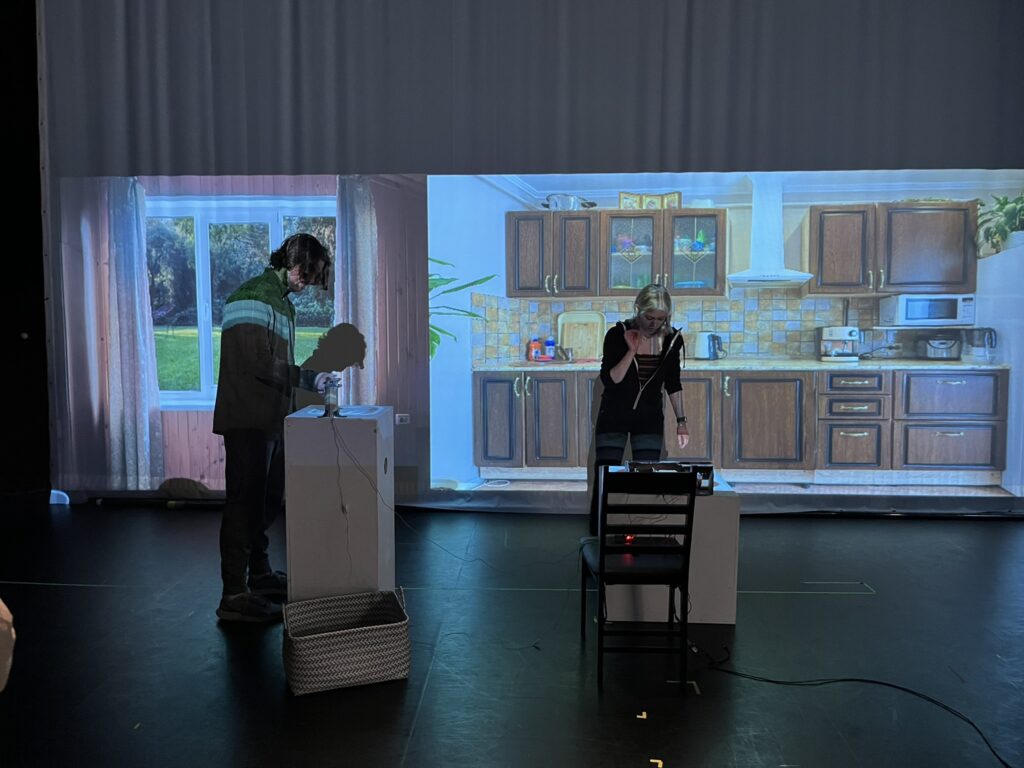Cycle 3: House of Discovery
Posted: December 15, 2023 Filed under: Uncategorized Leave a comment »
For cycle 3, my main mission was to put all of my elements together. I had the stove/makey-makey element I had created for cycle 1, as well as the projection mappings I had done for cycle 2, and I needed to pull them together in order to make the experience I had set out to originally.
After a lot of thought about how to connect users to ground when using the stove and sink, I realized that I could easily do it by using separate piece of tinfoil on either side of each knob. This whole time, I had each knob wrapped in one singular piece, but by breaking that apart and connecting one side to ground and the other to its correct input, I could easily ground each user without making people take shoes off or touching other tinfoil elements (both options I cam dangerously close to doing!). Of course, this dawned on me the night before we were presenting our cycle 3s, which ended in me reworking a lot of my makey-makey design from cycle 1. However, I found this experience to be very representative of the RSVP cycle and creative process in general. Especially when you’re working “solo” (all work is collaborative to some extent), the sometimes obvious answer can be staring you in the face, and it just takes a while for you to find it.
Still, this ground answer was a big breakthrough for me. All that was left was to add some more elements to upgrade my kitchen to an actual house. I decided to add a window to the left of the kitchen scene. In the patch, I set it so that every so often, a man’s faint silhouette would appear in the backyard, giving the experiencer the sense that they were being watched. It was at this point where I also decided to add a living room on another scrim to add dimension to the experience. I was able to set up some chairs in front to set it up as if if could be a place people could gather. I even created a cardboard “vase” with flowers (also made of cardboard and duct tape) to add to the room’s design. Of course, this additional room added complexity with yet another projector (projector count is now 3) and Isadora stage (Isadora stage count also 3). It was a quick picture for me to keep track of my outputs, so the framing isn’t great, but here’s a picture of the matrix switcher with my outputs in it:

And here’s a picture of the living room during cycle 3’s presentation:

Finally, after the presentation, I find that I would definitely like to make some updates for a theoretical cycle 4. I would focus a lot more on making my patch and experience robust. Some of my elements didn’t quite work during the showcase (thanks to a quick change and fault in logic on my part and OneDrive refusing to sync the morning of), so I’d like to focus on user testing and experience framing. There’s a lot to my idea that I don’t think I translated well into my cycle 3. I think the idea itself was big, so it was hard to tackle it all. If I were to go back to cycle 1, I would definitely downsize, making it easier for myself to have a more robust experience by the time we got to cycle 3. However, I could also 100% see myself saying I would want more time even if we had a cycle 4 and even 5. Since the RSVP cycle never ends, I’ll never quite be “happy” with the output. There’s always something to tweak.
However, I’m still quite proud of what I accomplished in the time given, and most of all what I learned. I never would have known how to do any of this–Isadora programming, projection mapping, experience design–before this class, and it’s given me a lot of ideas for the future and ongoing possibilities. Although I might not get a cycle 4 in the same context as these first 3 cycles, I’m excited to see where my new skills take me in the future.
Thank you all for this class–it’s been amazing, and I’ve truly enjoyed it and am endlessly grateful for this experience!